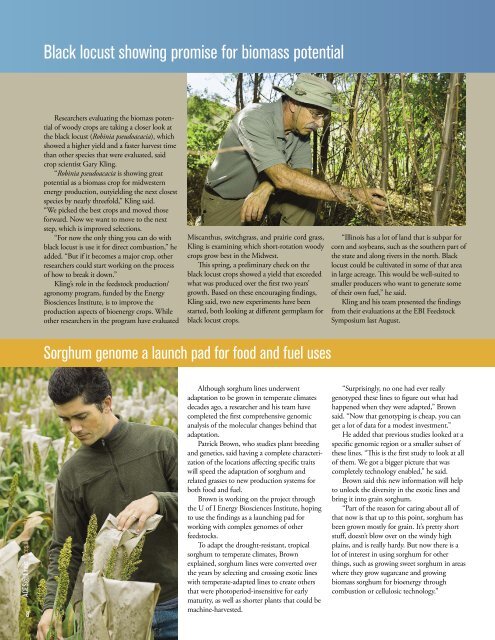t7W0J
t7W0J
t7W0J
Create successful ePaper yourself
Turn your PDF publications into a flip-book with our unique Google optimized e-Paper software.
Black locust showing promise for biomass potentialResearchers evaluating the biomass poten -tial of woody crops are taking a closer look atthe black locust (Robinia pseudoacacia), whichshowed a higher yield and a faster harvest timethan other species that were evaluated, saidcrop scientist Gary Kling.“Robinia pseudoacacia is showing greatpotential as a biomass crop for midwesternenergy production, outyielding the next closestspecies by nearly threefold,” Kling said.“We picked the best crops and moved thoseforward. Now we want to move to the nextstep, which is improved selections.“For now the only thing you can do withblack locust is use it for direct combustion,” headded. “But if it becomes a major crop, otherresearchers could start working on the processof how to break it down.”Kling’s role in the feedstock production/agronomy program, funded by the EnergyBiosciences Institute, is to improve theproduction aspects of bioenergy crops. Whileother researchers in the program have evaluatedMiscanthus, switchgrass, and prairie cord grass,Kling is examining which short-rotation woodycrops grow best in the Midwest.This spring, a preliminary check on theblack locust crops showed a yield that exceededwhat was produced over the first two years’growth. Based on these encouraging findings,Kling said, two new experiments have beenstarted, both looking at different germplasm forblack locust crops.“Illinois has a lot of land that is subpar forcorn and soybeans, such as the southern part ofthe state and along rivers in the north. Blacklocust could be cultivated in some of that areain large acreage. This would be well-suited tosmaller producers who want to generate someof their own fuel,” he said.Kling and his team presented the findingsfrom their evaluations at the EBI FeedstockSymposium last August.Sorghum genome a launch pad for food and fuel uses8ACES@Illinois aces.illinois.eduAlthough sorghum lines underwentadaptation to be grown in temperate climatesdecades ago, a researcher and his team havecompleted the first comprehensive genomicanalysis of the molecular changes behind thatadaptation.Patrick Brown, who studies plant breedingand genetics, said having a complete characterizationof the locations affecting specific traitswill speed the adaptation of sorghum andrelated grasses to new production systems forboth food and fuel.Brown is working on the project throughthe U of I Energy Biosciences Institute, hopingto use the findings as a launching pad forworking with complex genomes of otherfeedstocks.To adapt the drought-resistant, tropicalsorghum to temperate climates, Brownexplained, sorghum lines were converted overthe years by selecting and crossing exotic lineswith temperate-adapted lines to create othersthat were photoperiod-insensitive for earlymaturity, as well as shorter plants that could bemachine-harvested.“Surprisingly, no one had ever reallygenotyped these lines to figure out what hadhappened when they were adapted,” Brownsaid. “Now that genotyping is cheap, you canget a lot of data for a modest investment.”He added that previous studies looked at aspecific genomic region or a smaller subset ofthese lines. “This is the first study to look at allof them. We got a bigger picture that wascompletely technology enabled,” he said.Brown said this new information will helpto unlock the diversity in the exotic lines andbring it into grain sorghum.“Part of the reason for caring about all ofthat now is that up to this point, sorghum hasbeen grown mostly for grain. It’s pretty shortstuff, doesn’t blow over on the windy highplains, and is really hardy. But now there is alot of interest in using sorghum for otherthings, such as growing sweet sorghum in areaswhere they grow sugarcane and growingbiomass sorghum for bioenergy throughcombustion or cellulosic technology.”


